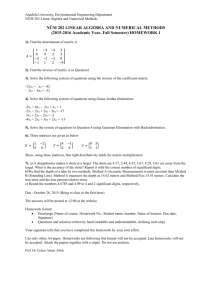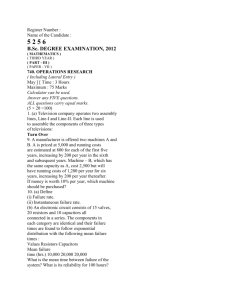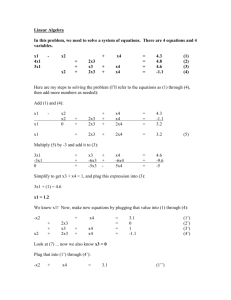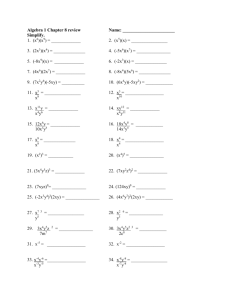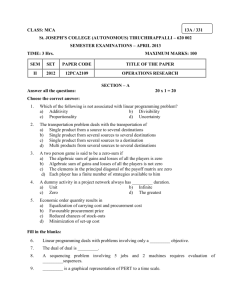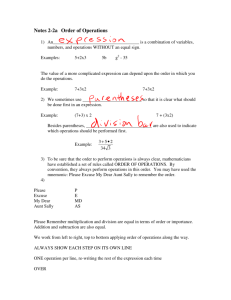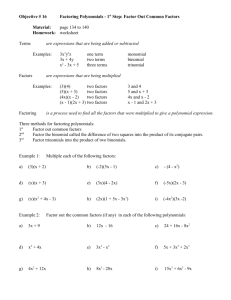The Simplex Algorithm - University of Washington
advertisement
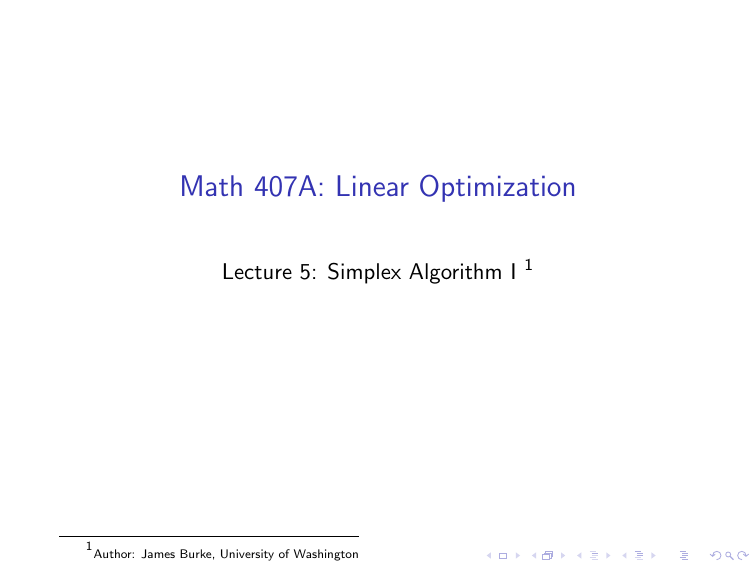
Math 407A: Linear Optimization
Lecture 5: Simplex Algorithm I
1
Author: James Burke, University of Washington
1
Dictionaries, Augmented Matrices, the Simplex Tableau
Dictionaries
The Simplex Tableau
Basic Feasible Solutions (BFS)
The Grand Strategy: Pivoting
The Simplex Algorithm in Matrix Form
The Simplex Algorithm in Matrix Form
The Simplex Algorithm
We develop a method for solving standard form LPs.
The Simplex Algorithm
We develop a method for solving standard form LPs.
max 5x1 + 4x2 + 3x3
s.t. 2x1 + 3x2 + x3 ≤ 5
4x1 + x2 + 2x3 ≤ 11
3x1 + 4x2 + 2x3 ≤ 8
0 ≤ x1 , x2 , x3
The Simplex Algorithm
We develop a method for solving standard form LPs.
max 5x1 + 4x2 + 3x3
s.t. 2x1 + 3x2 + x3 ≤ 5
4x1 + x2 + 2x3 ≤ 11
3x1 + 4x2 + 2x3 ≤ 8
0 ≤ x1 , x2 , x3
At this point we only have one tool to attack linear systems;
The Simplex Algorithm
We develop a method for solving standard form LPs.
max 5x1 + 4x2 + 3x3
s.t. 2x1 + 3x2 + x3 ≤ 5
4x1 + x2 + 2x3 ≤ 11
3x1 + 4x2 + 2x3 ≤ 8
0 ≤ x1 , x2 , x3
At this point we only have one tool to attack linear systems;
Gaussian elimination for solving linear systems of equations.
The Simplex Algorithm
We develop a method for solving standard form LPs.
max 5x1 + 4x2 + 3x3
s.t. 2x1 + 3x2 + x3 ≤ 5
4x1 + x2 + 2x3 ≤ 11
3x1 + 4x2 + 2x3 ≤ 8
0 ≤ x1 , x2 , x3
At this point we only have one tool to attack linear systems;
Gaussian elimination for solving linear systems of equations.
Let’s try to use it.
Dictionaries
We must first build a linear system of equations that encodes all of
the information associated with the LP.
Dictionaries
We must first build a linear system of equations that encodes all of
the information associated with the LP.
max 5x1 + 4x2 + 3x3
s.t. 2x1 + 3x2 + x3 ≤ 5
4x1 + x2 + 2x3 ≤ 11
3x1 + 4x2 + 2x3 ≤ 8
0 ≤ x1 , x2 , x3
Slack Variables and Dictionaries
For each linear inequality we introduce a new variable, called a
slack variable, so that we can write each linear inequality as an
equation.
Slack Variables and Dictionaries
For each linear inequality we introduce a new variable, called a
slack variable, so that we can write each linear inequality as an
equation.
x4 = 5 − [2x1 + 3x2 + x3 ] ≥ 0,
x5 = 11 − [4x1 + x2 + 2x3 ] ≥ 0,
x6 = 8 − [3x1 + 4x2 + 2x3 ] ≥ 0.
Slack Variables and Dictionaries
For each linear inequality we introduce a new variable, called a
slack variable, so that we can write each linear inequality as an
equation.
x4 = 5 − [2x1 + 3x2 + x3 ] ≥ 0,
x5 = 11 − [4x1 + x2 + 2x3 ] ≥ 0,
x6 = 8 − [3x1 + 4x2 + 2x3 ] ≥ 0.
Slack Variables: x4 , x5 , x6
Slack Variables and Dictionaries
For each linear inequality we introduce a new variable, called a
slack variable, so that we can write each linear inequality as an
equation.
x4 = 5 − [2x1 + 3x2 + x3 ] ≥ 0,
x5 = 11 − [4x1 + x2 + 2x3 ] ≥ 0,
x6 = 8 − [3x1 + 4x2 + 2x3 ] ≥ 0.
Slack Variables: x4 , x5 , x6
Next we introduce a variable to represent the objective.
Slack Variables and Dictionaries
For each linear inequality we introduce a new variable, called a
slack variable, so that we can write each linear inequality as an
equation.
x4 = 5 − [2x1 + 3x2 + x3 ] ≥ 0,
x5 = 11 − [4x1 + x2 + 2x3 ] ≥ 0,
x6 = 8 − [3x1 + 4x2 + 2x3 ] ≥ 0.
Slack Variables: x4 , x5 , x6
Next we introduce a variable to represent the objective.
z = 5x1 + 4x2 + 3x3 .
Slack Variables and Dictionaries
For each linear inequality we introduce a new variable, called a
slack variable, so that we can write each linear inequality as an
equation.
x4 = 5 − [2x1 + 3x2 + x3 ] ≥ 0,
x5 = 11 − [4x1 + x2 + 2x3 ] ≥ 0,
x6 = 8 − [3x1 + 4x2 + 2x3 ] ≥ 0.
Slack Variables: x4 , x5 , x6
Next we introduce a variable to represent the objective.
z = 5x1 + 4x2 + 3x3 .
This system of equations is called a dictionary for the the LP.
Dictionaries, Augmented Matrices, the Simplex Tableau
The LP is now encoded as the system
Dictionaries, Augmented Matrices, the Simplex Tableau
The LP is now encoded as the system
2x1 + 3x2 + x3 + x4
4x1 + x2 + 2x3
+ x5
3x2 + 4x2 + 2x3
+ x6
−z + 5x1 + 4x2 + 3x3
0 ≤ x1 , x2 , x3 , x4 , x5 , x6 .
= 5
= 11
= 8
= 0
Dictionaries, Augmented Matrices, the Simplex Tableau
The associated augmented matrix is
Dictionaries, Augmented Matrices, the Simplex Tableau
The associated augmented
0 2
0 4
0 3
−1 5
matrix is
3
1
4
4
1
2
2
3
1
0
0
0
0
1
0
0
0 5
0 11
1 8
0 0
Dictionaries, Augmented Matrices, the Simplex Tableau
The associated augmented
0 2
0 4
0 3
−1 5
matrix is
3
1
4
4
with 0 ≤ x1 , x2 , x3 , x4 , x5 , x6 .
1
2
2
3
1
0
0
0
0
1
0
0
0 5
0 11
1 8
0 0
Dictionaries, Augmented Matrices, the Simplex Tableau
The associated augmented
0 2
0 4
0 3
−1 5
matrix is
3
1
4
4
with 0 ≤ x1 , x2 , x3 , x4 , x5 , x6 .
1
2
2
3
1
0
0
0
0
1
0
0
0 5
0 11
1 8
0 0
Dictionaries, Augmented Matrices, the Simplex Tableau
The associated augmented
0 2
0 4
0 3
−1 5
matrix is
3
1
4
4
1
2
2
3
1
0
0
0
0
1
0
0
0 5
0 11
1 8
0 0
with 0 ≤ x1 , x2 , x3 , x4 , x5 , x6 .
This augmented matrix is called the initial simplex tableau.
Basic and Nonbasic Variables
Recall the initial dictionary for our LP:
Basic and Nonbasic Variables
Recall the initial dictionary for our LP:
x4
x5
x6
z
= 5 −2x1 −3x2 −x3
= 11 −4x1 −x2 −2x3
= 8 −3x1 −4x2 −2x3
=
5x1 +4x2 +3x3
Basic and Nonbasic Variables
Recall the initial dictionary for our LP:
x4
x5
x6
z
= 5 −2x1 −3x2 −x3
= 11 −4x1 −x2 −2x3
= 8 −3x1 −4x2 −2x3
=
5x1 +4x2 +3x3
We call the decision variables on the left (x4 , x4 , x6 ) the basic
variables, and those on the right the nonbasic variables (x1 , x2 , x3 ).
Basic and Nonbasic Variables
Recall the initial dictionary for our LP:
x4
x5
x6
z
basic
= 5 −2x1 −3x2 −x3
= 11 −4x1 −x2 −2x3
= 8 −3x1 −4x2 −2x3
=
5x1 +4x2 +3x3
nonbasic
We call the decision variables on the left (x4 , x4 , x6 ) the basic
variables, and those on the right the nonbasic variables (x1 , x2 , x3 ).
Basic Solutions Identified by Dictionaries
We think of the nonbasic variables as taking the value zero. This
determines the value of the basic variables and the objective z.
Basic Solutions Identified by Dictionaries
We think of the nonbasic variables as taking the value zero. This
determines the value of the basic variables and the objective z.
x4
x5
x6
z
= 5 −2x1 −3x2 −x3
= 11 −4x1 −x2 −2x3
= 8 −3x1 −4x2 −2x3
=
5x1 +4x2 +3x3
Basic Solutions Identified by Dictionaries
We think of the nonbasic variables as taking the value zero. This
determines the value of the basic variables and the objective z.
x4
x5
x6
z
= 5 −2x1 −3x2 −x3
= 11 −4x1 −x2 −2x3
= 8 −3x1 −4x2 −2x3
=
5x1 +4x2 +3x3
Nonbasic: x1 = x2 = x3 = 0
Basic Solutions Identified by Dictionaries
We think of the nonbasic variables as taking the value zero. This
determines the value of the basic variables and the objective z.
x4
x5
x6
z
= 5 −2x1 −3x2 −x3
= 11 −4x1 −x2 −2x3
= 8 −3x1 −4x2 −2x3
=
5x1 +4x2 +3x3
Nonbasic: x1 = x2 = x3 = 0
Basic: x4 = 5, x5 = 11, x6 = 8, z = 0
Basic Feasible Solutions (BFS)
The basic solution
x1 = x2 = x3 = 0 x4 = 5, x5 = 11, x6 = 8
is feasible for the LP
max 5x1 + 4x2 + 3x3
s.t. 2x1 + 3x2 + x3 ≤ 5
4x1 + x2 + 2x3 ≤ 11
3x1 + 4x2 + 2x3 ≤ 8
0 ≤ x1 , x2 , x3
Basic Feasible Solutions (BFS)
The basic solution
x1 = x2 = x3 = 0 x4 = 5, x5 = 11, x6 = 8
is feasible for the LP
max 5x1 + 4x2 + 3x3
s.t. 2x1 + 3x2 + x3 ≤ 5
4x1 + x2 + 2x3 ≤ 11
3x1 + 4x2 + 2x3 ≤ 8
0 ≤ x1 , x2 , x3
Such basic solutions are called basic feasible solutions (BFS).
Basic Feasible Solutions (BFS)
The basic solution
x1 = x2 = x3 = 0 x4 = 5, x5 = 11, x6 = 8
is feasible for the LP
max 5x1 + 4x2 + 3x3
s.t. 2x1 + 3x2 + x3 ≤ 5
4x1 + x2 + 2x3 ≤ 11
3x1 + 4x2 + 2x3 ≤ 8
0 ≤ x1 , x2 , x3
Such basic solutions are called basic feasible solutions (BFS).
The associated dictionary is said to be a feasible dictionary.
Basic Feasible Solutions (BFS)
The basic solution
x1 = x2 = x3 = 0 x4 = 5, x5 = 11, x6 = 8
is feasible for the LP
max 5x1 + 4x2 + 3x3
s.t. 2x1 + 3x2 + x3 ≤ 5
4x1 + x2 + 2x3 ≤ 11
3x1 + 4x2 + 2x3 ≤ 8
0 ≤ x1 , x2 , x3
Such basic solutions are called basic feasible solutions (BFS).
The associated dictionary is said to be a feasible dictionary.
In particular, this LP is said to have feasible origin.
Grand Strategy: Pivoting
Move from one feasible dictionary to another increasing the value
of the objective each time.
Grand Strategy: Pivoting
Move from one feasible dictionary to another increasing the value
of the objective each time.
x4
x5
x6
z
= 5 −2x1 −3x2 −x3
= 11 −4x1 −x2 −2x3
= 8 −3x1 −4x2 −2x3
=
5x1 +4x2 +3x3
Grand Strategy: Pivoting
Move from one feasible dictionary to another increasing the value
of the objective each time.
x4
x5
x6
z
= 5 −2x1 −3x2 −x3
= 11 −4x1 −x2 −2x3
= 8 −3x1 −4x2 −2x3
=
5x1 +4x2 +3x3
We do this by choosing a nonbasic variable with a positive
coefficient, and then increase its value from zero as much as we
can while maintaining feasibility.
Grand Strategy: Pivoting
Move from one feasible dictionary to another increasing the value
of the objective each time.
x4
x5
x6
z
= 5 −2x1 −3x2 −x3
= 11 −4x1 −x2 −2x3
= 8 −3x1 −4x2 −2x3
=
5x1 +4x2 +3x3
↑
We do this by choosing a nonbasic variable with a positive
coefficient, and then increase its value from zero as much as we
can while maintaining feasibility.
Grand Strategy: Pivoting
Move from one feasible dictionary to another increasing the value
of the objective each time.
x4
x5
x6
z
= 5 −2x1 −3x2 −x3
= 11 −4x1 −x2 −2x3
= 8 −3x1 −4x2 −2x3
=
5x1 +4x2 +3x3
↑
We do this by choosing a nonbasic variable with a positive
coefficient, and then increase its value from zero as much as we
can while maintaining feasibility.
Grand Strategy: Pivoting
Move from one feasible dictionary to another increasing the value
of the objective each time.
x4
x5
x6
z
= 5 −2x1 −3x2 −x3
= 11 −4x1 −x2 −2x3
= 8 −3x1 −4x2 −2x3
=
5x1 +4x2 +3x3
↑
We do this by choosing a nonbasic variable with a positive
coefficient, and then increase its value from zero as much as we
can while maintaining feasibility.
Pivoting
Let us increase the value of x1 from zero.
How much can we increase x1 and keep all other variables
non-negative?
Pivoting
Let us increase the value of x1 from zero.
How much can we increase x1 and keep all other variables
non-negative?
Consider the equation
0 ≤ x4 = 5 − 2x1 − 3x2 − x3 .
Pivoting
Let us increase the value of x1 from zero.
How much can we increase x1 and keep all other variables
non-negative?
Consider the equation
0 ≤ x4 = 5 − 2x1 − 3x2 − x3 .
Keeping x4 non-negative implies that we cannot increase x1 by
more than 5/2. Any further increase will push x4 negative.
Pivoting
Next consider the variable x5 :
0 ≤ x5 = 11 − 4x1 − x2 − 2x3 .
Pivoting
Next consider the variable x5 :
0 ≤ x5 = 11 − 4x1 − x2 − 2x3 .
Therefore, we cannot increase x1 by more than 11/4.
Pivoting
Next consider the variable x5 :
0 ≤ x5 = 11 − 4x1 − x2 − 2x3 .
Therefore, we cannot increase x1 by more than 11/4.
Similarly, for x6 we have
0 ≤ x6 = 8 − 3x1 − 4x2 − 2x3 .
Pivoting
Next consider the variable x5 :
0 ≤ x5 = 11 − 4x1 − x2 − 2x3 .
Therefore, we cannot increase x1 by more than 11/4.
Similarly, for x6 we have
0 ≤ x6 = 8 − 3x1 − 4x2 − 2x3 .
Therefore, we cannot increase x1 by more than 8/3.
Pivoting
Next consider the variable x5 :
0 ≤ x5 = 11 − 4x1 − x2 − 2x3 .
Therefore, we cannot increase x1 by more than 11/4.
Similarly, for x6 we have
0 ≤ x6 = 8 − 3x1 − 4x2 − 2x3 .
Therefore, we cannot increase x1 by more than 8/3.
Hence, we must have
x1 ≤ min{5/2, 11/4, 8/3} = 5/2 .
Pivoting
x4
x5
x6
z
= 5 −2x1 −3x2 −x3
= 11 −4x1 −x2 −2x3
= 8 −3x1 −4x2 −2x3
=
5x1 +4x2 +3x3
Pivoting
x4
x5
x6
z
= 5 −2x1 −3x2 −x3
= 11 −4x1 −x2 −2x3
= 8 −3x1 −4x2 −2x3
=
5x1 +4x2 +3x3
ratios
5/2
Pivoting
x4
x5
x6
z
= 5 −2x1 −3x2 −x3
= 11 −4x1 −x2 −2x3
= 8 −3x1 −4x2 −2x3
=
5x1 +4x2 +3x3
ratios
5/2
11/4
Pivoting
x4
x5
x6
z
= 5 −2x1 −3x2 −x3
= 11 −4x1 −x2 −2x3
= 8 −3x1 −4x2 −2x3
=
5x1 +4x2 +3x3
ratios
5/2
11/4
8/3
Pivoting
x4
x5
x6
z
= 5 −2x1 −3x2 −x3
= 11 −4x1 −x2 −2x3
= 8 −3x1 −4x2 −2x3
=
5x1 +4x2 +3x3
ratios
5/2
11/4
8/3
← smallest ratio
Pivoting
x4
x5
x6
z
= 5 −2x1 −3x2 −x3
= 11 −4x1 −x2 −2x3
= 8 −3x1 −4x2 −2x3
=
5x1 +4x2 +3x3
ratios
5/2
11/4
8/3
← smallest ratio
If we increase x1 to 5/2, then x4 decreases to zero.
Pivoting
x4
x5
x6
z
= 5 −2x1 −3x2 −x3
= 11 −4x1 −x2 −2x3
= 8 −3x1 −4x2 −2x3
=
5x1 +4x2 +3x3
ratios
5/2
11/4
8/3
← smallest ratio
If we increase x1 to 5/2, then x4 decreases to zero.
In this case we say x4 leaves the basis and x1 enters.
Pivoting
x4
x5
x6
z
= 5 −2x1 −3x2 −x3
= 11 −4x1 −x2 −2x3
= 8 −3x1 −4x2 −2x3
=
5x1 +4x2 +3x3
ratios
5/2
11/4
8/3
← smallest ratio
If we increase x1 to 5/2, then x4 decreases to zero.
In this case we say x4 leaves the basis and x1 enters.
Moving x4 to the rhs and x1 to the lhs gives
1
3
1
x1 = 5/2 − x4 − x2 − x3 .
2
2
2
Pivoting
We now have
Pivoting
We now have
x1
x5
x6
z
= (5/2) −(1/2)x4 −(3/2)x2 −(1/2)x3
=
11
−4x1
−x2
−2x3
=
8
−3x1
−4x2
−2x3
=
5x1
+4x2
+3x3
Pivoting
We now have
x1
x5
x6
z
= (5/2) −(1/2)x4 −(3/2)x2 −(1/2)x3
=
11
−4x1
−x2
−2x3
=
8
−3x1
−4x2
−2x3
=
5x1
+4x2
+3x3
Now use the first equation to remove x1 from the rhs to recover a
dictionary.
Pivoting
x1
=
x5
=
=
x6
=
=
z
=
=
3
1
5 1
− x4 − x2 − x3
2 2 2
2
5 1
3
1
11 − 4
− x4 − x2 − x3 − x2 − 2x3
2 2
2
2
1 + 2x4 + 5x2
3
1
5 1
− x4 − x2 − x3 − 4x2 − 2x3
8−3
2 2
2
2
1 3
1
1
+ x4 + x2 − x3
2 2
2
2
5 1
3
1
5
− x4 − x2 − x3 + 4x2 + 3x3
2 2
2
2
25 5
7
1
− x4 − x2 + x3 .
2
2
2
2
New Dictionary
5 1
3
1
− x4 − x2 − x3
2 2
2
2
= 1 + 2x4 + 5x2
1 3
1
1
=
+ x4 + x2 − x3
2 2
2
2
25 5
7
1
=
− x4 − x2 + x3 ,
2
2
2
2
x1 =
x5
x6
z
New Dictionary
5 1
3
1
− x4 − x2 − x3
2 2
2
2
= 1 + 2x4 + 5x2
1 3
1
1
=
+ x4 + x2 − x3
2 2
2
2
25 5
7
1
=
− x4 − x2 + x3 ,
2
2
2
2
x1 =
x5
x6
z
New BFS:
New Dictionary
5 1
3
1
− x4 − x2 − x3
2 2
2
2
= 1 + 2x4 + 5x2
1 3
1
1
=
+ x4 + x2 − x3
2 2
2
2
25 5
7
1
=
− x4 − x2 + x3 ,
2
2
2
2
x1 =
x5
x6
z
New BFS:
Nonbasic Variables: x4 = x2 = x3 = 0
New Dictionary
5 1
3
1
− x4 − x2 − x3
2 2
2
2
= 1 + 2x4 + 5x2
1 3
1
1
=
+ x4 + x2 − x3
2 2
2
2
25 5
7
1
=
− x4 − x2 + x3 ,
2
2
2
2
x1 =
x5
x6
z
New BFS:
Nonbasic Variables: x4 = x2 = x3 = 0
Basic Variables: x1 = 5/2, x5 = 1, x6 = 1/2
New Dictionary
5 1
3
1
− x4 − x2 − x3
2 2
2
2
= 1 + 2x4 + 5x2
1 3
1
1
=
+ x4 + x2 − x3
2 2
2
2
25 5
7
1
=
− x4 − x2 + x3 ,
2
2
2
2
x1 =
x5
x6
z
New BFS:
Nonbasic Variables: x4 = x2 = x3 = 0
Basic Variables: x1 = 5/2, x5 = 1, x6 = 1/2
Objective value: z = 25/2
The Second Pivot
x1 =
x5 =
x6 =
z
=
5
2
− 12 x4 − 32 x2 − 21 x3
1 +2x4 +5x2
3
1
1
1
2 + 2 x4 + 2 x2 − 2 x3
25
2
− 52 x4 − 72 x2 + 21 x3
The Second Pivot
x1 =
x5 =
x6 =
z
=
5
2
− 12 x4 − 32 x2 − 21 x3
1 +2x4 +5x2
3
1
1
1
2 + 2 x4 + 2 x2 − 2 x3
25
2
− 52 x4 − 72 x2 + 21 x3
↑
pos.
The Second Pivot
ratios
x1 =
x5 =
x6 =
z
=
5
2
1
1
2
25
2
− 12 x4
+2x4
+ 32 x4
− 32 x2
+5x2
+ 12 x2
− 21 x3
− 21 x3
− 52 x4 − 72 x2 + 21 x3
↑
pos.
The Second Pivot
x1 =
x5 =
x6 =
z
=
5
2
1
1
2
25
2
− 12 x4
+2x4
+ 32 x4
− 32 x2
+5x2
+ 12 x2
− 21 x3
− 21 x3
− 52 x4 − 72 x2 + 21 x3
↑
pos.
ratios
5
The Second Pivot
x1 =
x5 =
x6 =
z
=
5
2
1
1
2
25
2
− 12 x4
+2x4
+ 32 x4
− 32 x2
+5x2
+ 12 x2
− 21 x3
ratios
5
− 21 x3
1
− 52 x4 − 72 x2 + 21 x3
↑
pos.
The Second Pivot
x1 =
x5 =
x6 =
z
=
5
2
1
1
2
25
2
− 12 x4
+2x4
+ 32 x4
− 32 x2
+5x2
+ 12 x2
− 21 x3
ratios
5
− 21 x3
1
− 52 x4 − 72 x2 + 21 x3
↑
pos.
→ smallest
The Second Pivot
x1 =
x5 =
x6 =
z
=
5
2
1
1
2
25
2
− 12 x4
+2x4
+ 32 x4
− 32 x2
+5x2
+ 12 x2
− 21 x3
ratios
5
− 21 x3
1
− 52 x4 − 72 x2 + 21 x3
↑
pos.
x3 enters the basis and x6 leaves.
→ smallest
The Second Pivot
x1 =
x5 =
x6 =
z
=
5
2
1
1
2
25
2
− 12 x4
+2x4
+ 32 x4
− 32 x2
+5x2
+ 12 x2
− 21 x3
ratios
5
− 21 x3
1
− 52 x4 − 72 x2 + 21 x3
↑
pos.
x3 enters the basis and x6 leaves.
x3 = 1 + 3x4 + x2 − 2x6
→ smallest
The Second Pivot
The new dictionary is
x3 = 1 + 3x4 + x2 − 2x6
x1 = 2 − 2x4 − 2x2 + x6
x5 = 1 + 2x4 + 2x2
z
= 13 − x4 − 3x2 − x6
The Second Pivot
The new dictionary is
x3 = 1 + 3x4 + x2 − 2x6
x1 = 2 − 2x4 − 2x2 + x6
x5 = 1 + 2x4 + 2x2
z
= 13 − x4 − 3x2 − x6
The BFS identified by this dictionary is
The Second Pivot
The new dictionary is
x3 = 1 + 3x4 + x2 − 2x6
x1 = 2 − 2x4 − 2x2 + x6
x5 = 1 + 2x4 + 2x2
z
= 13 − x4 − 3x2 − x6
The BFS identified by this dictionary is
Nonbasic variables: x4 = x2 = x6 = 0
The Second Pivot
The new dictionary is
x3 = 1 + 3x4 + x2 − 2x6
x1 = 2 − 2x4 − 2x2 + x6
x5 = 1 + 2x4 + 2x2
z
= 13 − x4 − 3x2 − x6
The BFS identified by this dictionary is
Nonbasic variables: x4 = x2 = x6 = 0
Basic variables: x1 = 2, x3 = 1, x5 = 1
The Second Pivot
The new dictionary is
x3 = 1 + 3x4 + x2 − 2x6
x1 = 2 − 2x4 − 2x2 + x6
x5 = 1 + 2x4 + 2x2
z
= 13 − x4 − 3x2 − x6
The BFS identified by this dictionary is
Nonbasic variables: x4 = x2 = x6 = 0
Basic variables: x1 = 2, x3 = 1, x5 = 1
Objective value: z = 13
The Third Pivot
x3 = 1 + 3x4 + x2 − 2x6
x1 = 2 − 2x4 − 2x2 + x6
x5 = 1 + 2x4 + 2x2
z
= 13 − x4 − 3x2 − x6
The Third Pivot
x3 = 1 + 3x4 + x2 − 2x6
x1 = 2 − 2x4 − 2x2 + x6
x5 = 1 + 2x4 + 2x2
z
= 13 − x4 − 3x2 − x6
What nonbasic variable should enter the basis?
The Third Pivot
x3 = 1 + 3x4 + x2 − 2x6
x1 = 2 − 2x4 − 2x2 + x6
x5 = 1 + 2x4 + 2x2
z
= 13 − x4 − 3x2 − x6
What nonbasic variable should enter the basis?
No candidate!
The Third Pivot
x3 = 1 + 3x4 + x2 − 2x6
x1 = 2 − 2x4 − 2x2 + x6
x5 = 1 + 2x4 + 2x2
z
= 13 − x4 − 3x2 − x6
What nonbasic variable should enter the basis?
No candidate! All have a negative coefficient in the z row.
The Third Pivot
x3 = 1 + 3x4 + x2 − 2x6
x1 = 2 − 2x4 − 2x2 + x6
x5 = 1 + 2x4 + 2x2
z
= 13 − x4 − 3x2 − x6
What nonbasic variable should enter the basis?
No candidate! All have a negative coefficient in the z row.
If we increase the value of any nonbasic variable, the value of the
objective will be reduced.
The Third Pivot
x3 = 1 + 3x4 + x2 − 2x6
x1 = 2 − 2x4 − 2x2 + x6
x5 = 1 + 2x4 + 2x2
z
= 13 − x4 − 3x2 − x6
What nonbasic variable should enter the basis?
No candidate! All have a negative coefficient in the z row.
If we increase the value of any nonbasic variable, the value of the
objective will be reduced.
What does this mean?
The Third Pivot
x3 = 1 + 3x4 + x2 − 2x6
x1 = 2 − 2x4 − 2x2 + x6
x5 = 1 + 2x4 + 2x2
z
= 13 − x4 − 3x2 − x6
What nonbasic variable should enter the basis?
No candidate! All have a negative coefficient in the z row.
If we increase the value of any nonbasic variable, the value of the
objective will be reduced.
What does this mean? The current BFS is optimal!
Optimal BFS and Dictionary
The optimal dictionary is
x3 = 1 + 3x4 + x2 − 2x6
x1 = 2 − 2x4 − 2x2 + x6
x5 = 1 + 2x4 + 2x2
z
= 13 − x4 − 3x2 − x6
Optimal BFS and Dictionary
The optimal dictionary is
x3 = 1 + 3x4 + x2 − 2x6
x1 = 2 − 2x4 − 2x2 + x6
x5 = 1 + 2x4 + 2x2
z
= 13 − x4 − 3x2 − x6
feasible
Optimal BFS and Dictionary
The optimal dictionary is
x3 = 1 + 3x4 + x2 − 2x6
x1 = 2 − 2x4 − 2x2 + x6
feasible
x5 = 1 + 2x4 + 2x2
z
= 13 − x4 − 3x2 − x6
→ all neg. coef.s
Optimal BFS and Dictionary
The optimal dictionary is
x3 = 1 + 3x4 + x2 − 2x6
x1 = 2 − 2x4 − 2x2 + x6
feasible
x5 = 1 + 2x4 + 2x2
z
= 13 − x4 − 3x2 − x6
→ all neg. coef.s
The optimal BFS is x = (2, 0, 1, 0, 1, 0)T .
Optimal BFS and Dictionary
The optimal dictionary is
x3 = 1 + 3x4 + x2 − 2x6
x1 = 2 − 2x4 − 2x2 + x6
feasible
x5 = 1 + 2x4 + 2x2
z
= 13 − x4 − 3x2 − x6
→ all neg. coef.s
The optimal BFS is x = (2, 0, 1, 0, 1, 0)T .
The optimal value is z = 13.
The Simplex Algorithm
The process of moving from one feasible dictionary to another is
called simplex pivoting.
The Simplex Algorithm
The process of moving from one feasible dictionary to another is
called simplex pivoting.
The process of pivoting from one feasible dictionary to the next
until optimality is obtained is called the simplex algorithm.
The Simplex Algorithm
The process of moving from one feasible dictionary to another is
called simplex pivoting.
The process of pivoting from one feasible dictionary to the next
until optimality is obtained is called the simplex algorithm.
A pivot corresponds to doing Gauss-Jordan elimination on the
column in the simplex tableau (augmented matrix) corresponding
to the incoming variable.
The Simplex Algorithm
The process of moving from one feasible dictionary to another is
called simplex pivoting.
The process of pivoting from one feasible dictionary to the next
until optimality is obtained is called the simplex algorithm.
A pivot corresponds to doing Gauss-Jordan elimination on the
column in the simplex tableau (augmented matrix) corresponding
to the incoming variable.
Hence the simplex algorithm is a process that can be applied
directly to the simplex tableau.
Simplex Pivoting on the Augmented Matrix
max 5x1 + 4x2 + 3x3
s.t. 2x1 + 3x2 + x3
≤ 5
4x1 + x2 + 2x3
≤ 11
3x1 + 4x2 + 2x3
≤ 8
0 ≤ x1 , x2 , x3
Recall the augmented matrix associated with the initial dictionary.
Simplex Pivoting on the Augmented Matrix
max 5x1 + 4x2 + 3x3
≤ 5
s.t. 2x1 + 3x2 + x3
4x1 + x2 + 2x3
≤ 11
3x1 + 4x2 + 2x3
≤ 8
0 ≤ x1 , x2 , x3
Recall the augmented matrix associated with the initial dictionary.
0 A I b
−1 c 0 0
0
= 0
0
−1
2
4
3
5
3
1
4
4
1
2
2
3
1
0
0
0
0
1
0
0
0 5
0 11
1 8
0 0
Simplex Pivoting on the Augmented Matrix
max 5x1 + 4x2 + 3x3
s.t. 2x1 + 3x2 + x3
≤ 5
4x1 + x2 + 2x3
≤ 11
3x1 + 4x2 + 2x3
≤ 8
0 ≤ x1 , x2 , x3
Recall the augmented matrix associated with the initial dictionary.
0 A I b
−1 c 0 0
z x1 x2
0 2 3
= 0 4 1
0 3 4
−1 5 4
x3
1
2
2
3
x4
1
0
0
0
x5
0
1
0
0
x6
0 5
0 11
1 8
0 0
Simplex Pivoting on the Augmented Matrix
max 5x1 + 4x2 + 3x3
s.t. 2x1 + 3x2 + x3
≤ 5
4x1 + x2 + 2x3
≤ 11
3x1 + 4x2 + 2x3
≤ 8
0 ≤ x1 , x2 , x3
Recall the augmented matrix associated with the initial dictionary.
0 A I b
−1 c 0 0
z x1 x2
0 2 3
= 0 4 1
0 3 4
−1 5 4
x3
1
2
2
3
x4
1
0
0
0
x5
0
1
0
0
x6
0 5
0 11
1 8
0 0
Simplex Pivoting on the Augmented Matrix
0
0
0 A I b
= 0
−1 c 0 0
−1
2
4
3
5
3
1
4
4
1
2
2
3
1
0
0
0
0
1
0
0
0 5
0 11
1 8
0 0
Simplex Pivoting on the Augmented Matrix
0
0
0 A I b
= 0
−1 c 0 0
−1
2
4
3
5
3
1
4
4
1
2
2
3
1
0
0
0
0
1
0
0
0 5
0 11
1 8
0 0
Simplex Pivoting on the Augmented Matrix
0
0
0 A I b
= 0
−1 c 0 0
−1
2
4
3
5
3
1
4
4
1
2
2
3
1
0
0
0
0
1
0
0
0 5
0 11
1 8
0 0
Simplex Pivoting on the Augmented Matrix
0
0
0 A I b
= 0
−1 c 0 0
−1
2
4
3
5
Which variables are in the basis?
3
1
4
4
1
2
2
3
1
0
0
0
↑
0
1
0
0
↑
0 5
0 11
1 8
0 0
↑
Simplex Pivoting on the Augmented Matrix
0
0
0 A I b
= 0
−1 c 0 0
−1
2
4
3
5
Which variables are in the basis?
Columns of the identity.
3
1
4
4
1
2
2
3
1
0
0
0
0
1
0
0
0 5
0 11
1 8
0 0
Simplex Pivoting on the Augmented Matrix
0
0
0 A I b
= 0
−1 c 0 0
−1
2
4
3
5
3
1
4
4
1
2
2
3
1
0
0
0
0
1
0
0
How do we choose the variable to enter the basis?
0 5
0 11
1 8
0 0
Simplex Pivoting on the Augmented Matrix
0
0
0 A I b
= 0
−1 c 0 0
−1
2
4
3
5
↑
3
1
4
4
1
2
2
3
1
0
0
0
0
1
0
0
How do we choose the variable to enter the basis?
0 5
0 11
1 8
0 0
Simplex Pivoting on the Augmented Matrix
0
0
0 A I b
= 0
−1 c 0 0
−1
2
4
3
5
↑
3
1
4
4
1
2
2
3
1
0
0
0
0
1
0
0
How do we choose the variable to enter the basis?
How do we choose the variable to leave the basis?
0 5
0 11
1 8
0 0
Simplex Pivoting on the Augmented Matrix
0
0
0 A I b
= 0
−1 c 0 0
−1
2
4
3
5
↑
3
1
4
4
1
2
2
3
1
0
0
0
0
1
0
0
How do we choose the variable to enter the basis?
How do we choose the variable to leave the basis?
0 5
0 11
1 8
0 0
ratios
5/2 ←
11/4
8/3
Simplex Tableau Pivot
ratios
↓
0
0
0
-1
2
4
3
5
3
1
4
4
1
2
2
3
1
0
0
0
0
1
0
0
0
0
1
0
5
11
8
0
5/2
11/4
8/3
Simplex Tableau Pivot
Pivot
column
↓
0
0
0
-1
2
4
3
5
ratios
3
1
4
4
1
2
2
3
1
0
0
0
0
1
0
0
0
0
1
0
5
11
8
0
5/2
11/4
8/3
Simplex Tableau Pivot
Pivot
column
↓
0
0
0
-1
2
4
3
5
ratios
3
1
4
4
1
2
2
3
1
0
0
0
0
1
0
0
0
0
1
0
5
11
8
0
5/2
11/4
8/3
Simplex Tableau Pivot
Pivot
column
↓
0
0
0
-1
2
4
3
5
ratios
3
1
4
4
1
2
2
3
1
0
0
0
0
1
0
0
0
0
1
0
5
11
8
0
5/2
11/4
8/3
←
Pivot row
Simplex Tableau Pivot
Pivot
column
↓
0
0
0
-1
2
0
ratios
4
3
5
3
1
4
4
1
2
2
3
1
0
0
0
0
1
0
0
0
0
1
0
5
11
8
0
1
3/2
1/2
1/2
0
0
5/2
5/2
11/4
8/3
←
Pivot row
Simplex Tableau Pivot
Pivot
column
↓
0
0
0
-1
2
0
0
ratios
4
3
5
3
1
4
4
1
2
2
3
1
0
0
0
0
1
0
0
0
0
1
0
5
11
8
0
1
0
3/2
−5
1/2
0
1/2
−2
0
1
0
0
5/2
1
5/2
11/4
8/3
←
Pivot row
Simplex Tableau Pivot
Pivot
column
↓
0
0
0
-1
2
0
0
0
ratios
4
3
5
3
1
4
4
1
2
2
3
1
0
0
0
0
1
0
0
0
0
1
0
5
11
8
0
1
0
0
3/2
−5
−1/2
1/2
0
1/2
1/2
−2
−3/2
0
1
0
0
0
1
5/2
1
1/2
5/2
11/4
8/3
←
Pivot row
Simplex Tableau Pivot
Pivot
column
↓
0
0
0
-1
2
ratios
4
3
5
3
1
4
4
1
2
2
3
1
0
0
0
0
1
0
0
0
0
1
0
5
11
8
0
0
0
0
1
0
0
3/2
−5
−1/2
1/2
0
1/2
1/2
−2
−3/2
0
1
0
0
0
1
5/2
1
1/2
−1
0
−7/2
1/2
−5/2
0
0
−25/2
5/2
11/4
8/3
←
Pivot row
Simplex Tableau and Its Dictionary
0
0
0
−1
1 3/2 1/2
0 −5
0
0 −1/2 1/2
0 −7/2 1/2
1/2
−2
−3/2
−5/2
0 0
1 0
0 1
0
5/2
1
,
1/2
−25/2
Simplex Tableau and Its Dictionary
0
0
0
−1
1 3/2 1/2
0 −5
0
0 −1/2 1/2
0 −7/2 1/2
1/2
−2
−3/2
−5/2
0 0
1 0
0 1
0
5/2
1
,
1/2
−25/2
This tableau is the augmented matrix for the dictionary
Simplex Tableau and Its Dictionary
0
0
0
−1
1 3/2 1/2
0 −5
0
0 −1/2 1/2
0 −7/2 1/2
1/2
−2
−3/2
−5/2
0 0
1 0
0 1
0
5/2
1
,
1/2
−25/2
This tableau is the augmented matrix for the dictionary
x1
=
x5
=
x6
=
z
=
5 1
3
1
− x4 − x2 − x3
2 2
2
2
1 + 2x4 + 5x2
1
1
1 3
+ x4 + x2 − x3
2 2
2
2
25 5
7
1
− x4 − x2 + x3 ,
2
2
2
2
Simplex Tableau and Its Dictionary
0
0
0
−1
1 3/2 1/2
0 −5
0
0 −1/2 1/2
0 −7/2 1/2
1/2
−2
−3/2
−5/2
0 0
1 0
0 1
0
5/2
1
,
1/2
−25/2
Simplex Tableau and Its Dictionary
0
0
0
−1
1 3/2 1/2
0 −5
0
0 −1/2 1/2
0 −7/2 1/2
x1
=
1/2
−2
−3/2
−5/2
0 0
1 0
0 1
0
3
1
5 1
− x4 − x2 − x3
2 2
2
2
5/2
1
,
1/2
−25/2
Simplex Tableau and Its Dictionary
0
0
0
−1
1 3/2 1/2
0 −5
0
0 −1/2 1/2
0 −7/2 1/2
x1
x5
1/2
−2
−3/2
−5/2
0 0
1 0
0 1
0
3
1
5 1
− x4 − x2 − x3
2 2
2
2
= 1 + 2x4 + 5x2
=
5/2
1
,
1/2
−25/2
Simplex Tableau and Its Dictionary
0
0
0
−1
1 3/2 1/2
0 −5
0
0 −1/2 1/2
0 −7/2 1/2
x1
x5
x6
1/2
−2
−3/2
−5/2
0 0
1 0
0 1
0
3
5 1
− x4 − x2 −
2 2
2
= 1 + 2x4 + 5x2
1
1 3
+ x4 + x2 −
=
2 2
2
=
1
x3
2
1
x3
2
5/2
1
,
1/2
−25/2
Simplex Tableau and Its Dictionary
0
0
0
−1
1 3/2 1/2
0 −5
0
0 −1/2 1/2
0 −7/2 1/2
x1
x5
x6
z
1/2
−2
−3/2
−5/2
0 0
1 0
0 1
0
5/2
1
,
1/2
−25/2
3
1
5 1
− x4 − x2 − x3
2 2
2
2
= 1 + 2x4 + 5x2
1
1
1 3
+ x4 + x2 − x3
=
2 2
2
2
25 5
7
1
=
− x4 − x2 + x3 ,
2
2
2
2
=
Second Simplex Pivot on the Tableau
0
0
0
−1
1
0
0
0
3/2
−5
−1/2
−7/2
1/2
0
1/2
1/2
1/2
−2
−3/2
−5/2
0
1
0
0
0
0
1
0
5/2
1
1/2
−25/2
Second Simplex Pivot on the Tableau
0
0
0
−1
1
0
0
0
3/2
−5
−1/2
−7/2
Pivot
column
↓
1/2
0
1/2
1/2
1/2
−2
−3/2
−5/2
0
1
0
0
0
0
1
0
5/2
1
1/2
−25/2
Second Simplex Pivot on the Tableau
0
0
0
−1
1
0
0
0
3/2
−5
−1/2
−7/2
Pivot
column
↓
1/2
0
1/2
1/2
ratios
1/2
−2
−3/2
−5/2
0
1
0
0
0
0
1
0
5/2
1
1/2
−25/2
5
1
Second Simplex Pivot on the Tableau
0
0
0
−1
1
0
0
0
3/2
−5
−1/2
−7/2
Pivot
column
↓
1/2
0
1/2
1/2
ratios
1/2
−2
−3/2
−5/2
0
1
0
0
0
0
1
0
5/2
1
1/2
−25/2
5
1
←
pivot row
Second Simplex Pivot on the Tableau
ratios
0
0
0
−1
1
0
0
0
3/2
−5
−1/2
−7/2
1/2
0
1/2
1/2
1/2
−2
−3/2
−5/2
0
1
0
0
0
0
1
0
5/2
1
1/2
−25/2
5
1
Second Simplex Pivot on the Tableau
ratios
0
0
0
−1
1
0
0
0
3/2
−5
−1/2
−7/2
1/2
0
1/2
1/2
−2
−3/2
−5/2
0
1
0
0
0
0
1
0
5/2
1
1/2
−25/2
1/2
0
0
−1
1
−3
0
2
1
5
1
Second Simplex Pivot on the Tableau
ratios
0
0
0
−1
1
0
0
0
3/2
−5
−1/2
−7/2
1/2
0
1/2
1/2
−2
−3/2
−5/2
0
1
0
0
0
0
1
0
5/2
1
1/2
−25/2
1/2
0
1
2
0
2
0
−1
2
0
0
−1
1
−3
0
2
1
5
1
Second Simplex Pivot on the Tableau
ratios
0
0
0
−1
1
0
0
0
3/2
−5
−1/2
−7/2
1/2
0
1/2
1/2
−2
−3/2
−5/2
0
1
0
0
0
0
1
0
5/2
1
1/2
−25/2
1/2
0
0
0
1
0
0
2
−5
−1
0
0
1
2
−2
−3
0
1
0
−1
0
2
2
1
1
5
1
Second Simplex Pivot on the Tableau
ratios
0
0
0
−1
1
0
0
0
3/2
−5
−1/2
−7/2
1/2
0
1/2
1/2
−2
−3/2
−5/2
0
1
0
0
0
0
1
0
5/2
1
1/2
−25/2
1/2
0
0
0
−1
1
0
0
0
2
−5
−1
−3
0
0
1
0
2
−2
−3
−1
0
1
0
0
−1
0
2
−1
2
1
1
−13
5
1
Second Simplex Pivot on the Tableau
ratios
0
0
0
−1
1
0
0
0
3/2
−5
−1/2
−7/2
1/2
0
1/2
1/2
−2
−3/2
−5/2
0
1
0
0
0
0
1
0
5/2
1
1/2
−25/2
1/2
0
0
0
−1
1
0
0
0
2
−5
−1
−3
0
0
1
0
2
−2
−3
−1
0
1
0
0
−1
0
2
−1
2
1
1
−13
Optimal Solution: (x1 , x2 , x3 ) = (2, 0, 1)
5
1
Second Simplex Pivot on the Tableau
ratios
0
0
0
−1
1
0
0
0
3/2
−5
−1/2
−7/2
1/2
0
1/2
1/2
−2
−3/2
−5/2
0
1
0
0
0
0
1
0
5/2
1
1/2
−25/2
1/2
0
0
0
−1
1
0
0
0
2
−5
−1
−3
0
0
1
0
2
−2
−3
−1
0
1
0
0
−1
0
2
−1
2
1
1
−13
Optimal Solution: (x1 , x2 , x3 ) = (2, 0, 1)
Optimal Value: z = 13
5
1
Recap: Tableau Pivoting
0
0
0
-1
2
4
3
5
3
1
4
4
1
2
2
3
1
0
0
0
0
1
0
0
0
0
1
0
5
11
8
0
0
0
0
−1
1
0
0
0
3/2
−5
−1/2
−7/2
1/2
0
1/2
1/2
1/2
−2
−3/2
−5/2
0
1
0
0
0
0
1
0
5/2
1
1/2
−25/2
0
0
0
−1
1
0
0
0
2
−5
−1
−3
0
0
1
0
2
−2
−3
−1
0
1
0
0
−1
0
2
−1
2
1
1
−13
Remove z Column
2
4
3
5
3
1
4
4
1
2
2
3
1
0
0
0
0
1
0
0
0
0
1
0
5
11
8
0
1
0
0
0
3/2
−5
−1/2
−7/2
1/2
0
1/2
1/2
1/2
−2
−3/2
−5/2
0
1
0
0
0
0
1
0
5/2
1
1/2
−25/2
1
0
0
0
2
−5
−1
−3
0
0
1
0
2
−2
−3
−1
0
1
0
0
−1
0
2
−1
2
1
1
−13
Another Example
− 4z
maximize
3x
+ 2y
subject to
x
2x
x
0
+ 4y
+ 4y − 2z
+ y − 2z
≤ x, y , z
≤ 5
≤ 6
≤ 2
Second Example: Tableau Pivoting
1
2
3
4
4
1
2
0
0
1
0
3
2
1
−1
0
0
1
0
1
1
3
−3
1
0
-2
-2
-4
1
0
0
0
0
1
0
0
0
0
1
0
5
6
2
0
2
−2
2
1
0
0
0
0
1
0
0
-1
-2
1
−3
3
2
2
−6
0
1
0
0
1
0
0
0
−1
1/2
1
−1
1
−1
−1
−1
1
1
4
−8
2
ratios
5
3
2
3/2
1
